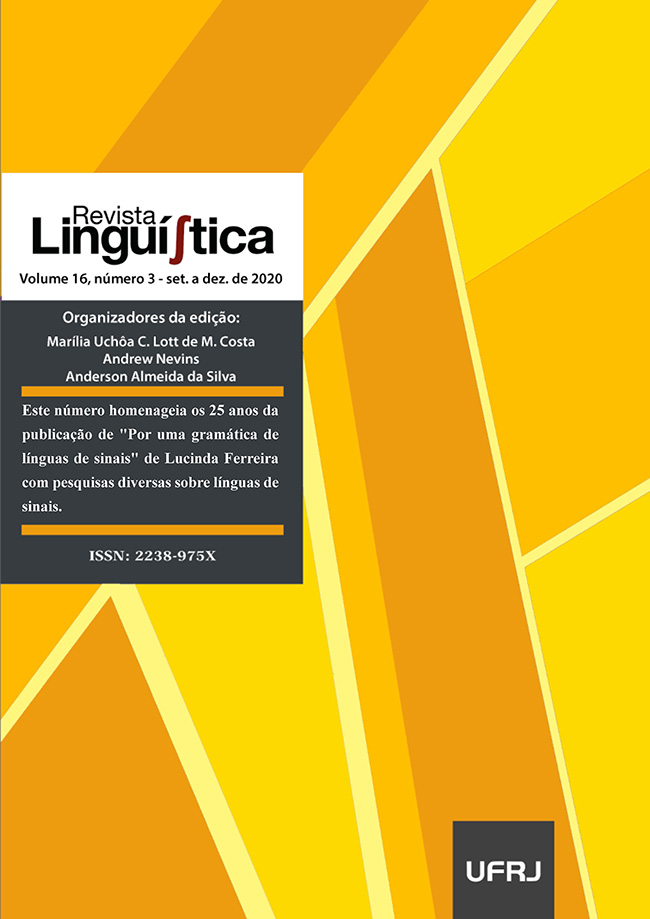Reference switching in sign and speech: grammatical and discourse features across modalities within signed-to-spoken language interpretation
DOI:
https://doi.org/10.31513/linguistica.2020.v16n3a37192Palavras-chave:
referência, pronomes, deslocamento de papéis, ação construída, lateralidade, interpretação.Resumo
Human languages contain a variety of tools for referencing agents, locations, arguments of predicates, and other entities that are introduced, described, and attributed actions within sentences. While there are similarities across modalities, there also exist notable differences. For example, signed languages are articulated with two hands, and sometimes one of them serves referencing functions while the other produces complementary signs. Additionally, signers use role shift and constructed action extensively, whereas there is comparatively less use of reported speech and co-speech enactment in spoken language discourse. Differences across modalities such as these provide areas of focus for studies of interpretation, since a common theoretical premise is that interpreters should disengage from the form of a source-language message in order to provide the meaning in the target language (with its own form). It is open to debate whether an interpretation can achieve complete semantic equivalence, given differences in the grammars, lexical items, and discourse features of the source- and target-languages. We use Libras texts interpreted into Brazilian Portuguese to examine various types of referencing in language and how it occurs in such texts. Our analysis is intended to raise questions about referencing and interpretation that merit in-depth study.
-----------------------------------------------------------------------------
ALTERNÂNCIA DE REFERÊNCIA NAS LÍNGUAS DE SINAIS E LÍNGUAS FALADAS: CARACTERÍSTICAS GRAMATICAIS E DISCURSIVAS ENTRE MODALIDADES EM INTERPRETAÇÕES DE LIBRAS PARA LÍNGUA PORTUGUESA
As línguas humanas contêm uma variedade de ferramentas para referenciar agentes, locais, argumentos de predicados e outras entidades que são introduzidas, descritas e atribuídas com ações nas sentenças. Embora existam semelhanças entre as modalidades, também existem diferenças notáveis. Por exemplo, as línguas de sinais são articuladas com duas mãos, e às vezes uma delas tem funções de referência enquanto a outra produz sinais complementares. Além disso, o sinalizador usa a alternância de referência e a ação construída extensivamente, enquanto há comparativamente menos uso de cotação e ação construída que co-ocorre com discurso da língua falada. Diferenças entre modalidades como essas fornecem áreas de foco para estudos da interpretação, uma vez que uma premissa teórica comum é que os intérpretes devem se desvincular da forma de uma mensagem na língua de origem a fim de fornecer o significado na língua de destino (com sua própria forma). É possível debater se uma interpretação pode alcançar equivalência semântica completal, dadas as diferenças nas gramáticas, itens lexicais e características do discurso das línguas-fonte e as línguas-alvo. Usamos textos de Libras interpretados para o português brasileiro para examinar vários tipos de referência nessas línguas e como ela ocorre nesses textos. Nossa análise pretende levantar questões sobre referenciação e interpretação que merecem um estudo aprofundado.
---
Origina em inglês.
Downloads
Publicado
Edição
Seção
Licença
Autores que publicam na Revista Linguí∫tica concordam com os seguintes termos:
Os autores mantêm os direitos e cedem à revista o direito à primeira publicação, simultaneamente submetido a uma licença Creative Commons que permite o compartilhamento por terceiros com a devida menção ao autor e à primeira publicação pela Revista Linguí∫tica.
Os autores podem entrar em acordos contratuais adicionais e separados para a distribuição não exclusiva da versão publicada da obra (por exemplo, postá-la em um repositório institucional ou publicá-la em um livro), com o reconhecimento de sua publicação inicial na Revista Linguí∫tica.

A Revista Linguí∫tica é uma revista do Programa de Pós-Graduação em Linguística da UFRJ e se utiliza da Licença Creative Commons - Atribuição-NãoComercial 4.0 Internacional (CC-BY-NC)









